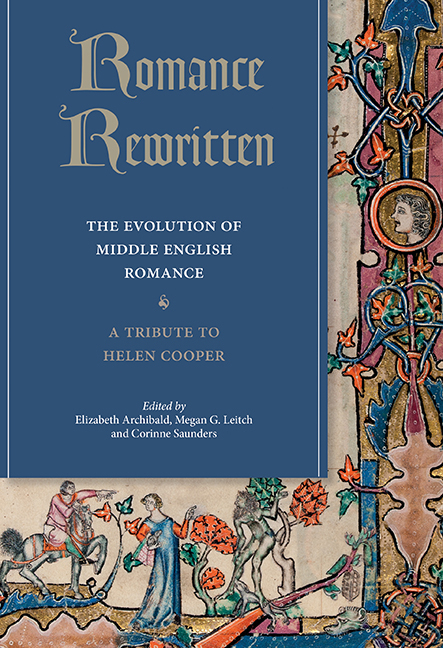Book contents
- Frontmatter
- Dedication
- Contents
- Notes on Contributors
- Acknowledgements
- Introduction. Middle English Romance: The Motifs and the Critics
- I Romance Disruptions
- II Romance and Narrative Strategies
- 4 Beginning with the Ending: Narrative Techniques and their Significance in Chaucer's Knight's Tale
- 5 The Riddle of ‘Apollonius’: ‘A Bok for King Richardes Sake’
- 6 Malory and the Post-Vulgate Cycle
- 7 Towards a Gestural Lexicon of Medieval English Romance
- III Romance and Spiritual Priorities
- IV Late Romance
- Works Cited
- Index
- Volumes Already Published
7 - Towards a Gestural Lexicon of Medieval English Romance
from II - Romance and Narrative Strategies
Published online by Cambridge University Press: 17 October 2019
- Frontmatter
- Dedication
- Contents
- Notes on Contributors
- Acknowledgements
- Introduction. Middle English Romance: The Motifs and the Critics
- I Romance Disruptions
- II Romance and Narrative Strategies
- 4 Beginning with the Ending: Narrative Techniques and their Significance in Chaucer's Knight's Tale
- 5 The Riddle of ‘Apollonius’: ‘A Bok for King Richardes Sake’
- 6 Malory and the Post-Vulgate Cycle
- 7 Towards a Gestural Lexicon of Medieval English Romance
- III Romance and Spiritual Priorities
- IV Late Romance
- Works Cited
- Index
- Volumes Already Published
Summary
What happens when an emotion is unreadable … when a bodily sign of emotion carries neither a familiar meaning nor an explanation within the text?
The focus of this essay forms part of a broader ongoing enquiry into body language in medieval English culture and in romances as part of that. It develops from the premise that examining patterns of body language over a representative selection of romances can build towards a gestural lexicon of both familiar and implicit meanings of body language, as well as furnishing explanations for instances unexplained within the text. This is not to imply that all romances are somehow the same, and that they will display monolithic uses of body language. The more exceptional incidences of body language which can be identified through a comparative survey serve both to confirm the broader idiom and define many fascinating variations. Such a gestural lexicon in a fuller form will have the potential to inform enquiries into medieval understanding of bodiliness and the history of the emotions.
Body language is usually interpreted to be all physical aspects, positions or motions of the body which have a meaning but do not serve a practical purpose. Any reader of medieval English romances notices patterns in the body language referenced. Some is persistently mentioned, while other types of body language may be rarely explored. Some is to be read within the expectations of social decorums (doffing headgear: Em 992; SPG 403) and ceremonious observance (bowing: Em 981; FB 702; SI 281, 335). Some has deliberate performative functions (as in various hand gestures which bestow and confer). Much other body language as described in romances might appear to embody outwardly the characters’ emotional life, but is it always to be read as expressive of an individual feeling and emotion?
It is possible to misread references to gesture within medieval romance, because modern readers are accustomed instinctively to visualise what they read in the mind's eye, and to interpret what is visualised in terms of emotional and psychological implication. Yet much recording of body language in medieval writing suggests that characters are reported to swoon, weep, or whatever, more as a token of the type of scene or situation than as something particularly revealing of an individual's unique experience.
- Type
- Chapter
- Information
- Romance RewrittenThe Evolution of Middle English Romance. A Tribute to Helen Cooper, pp. 133 - 152Publisher: Boydell & BrewerPrint publication year: 2018
- 1
- Cited by



